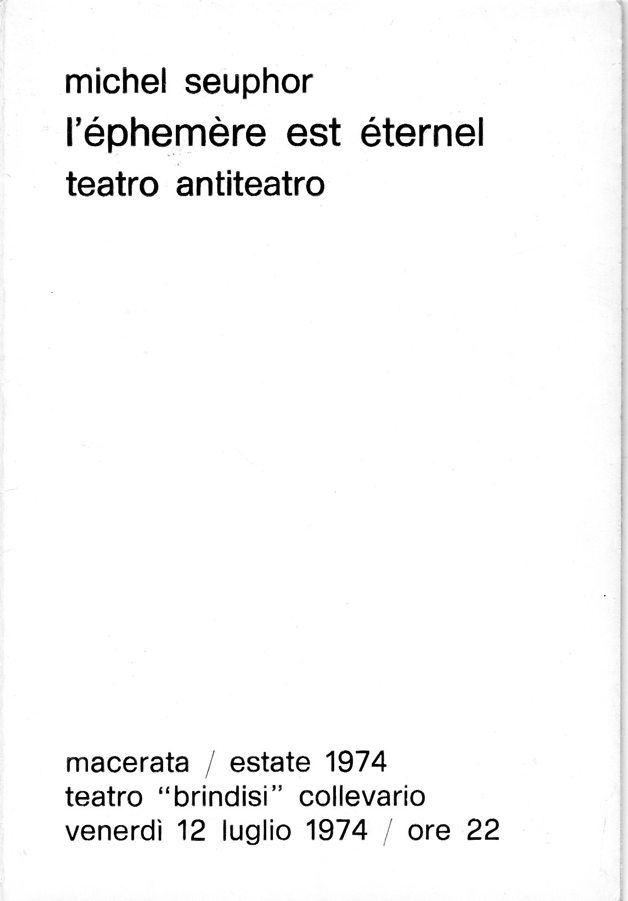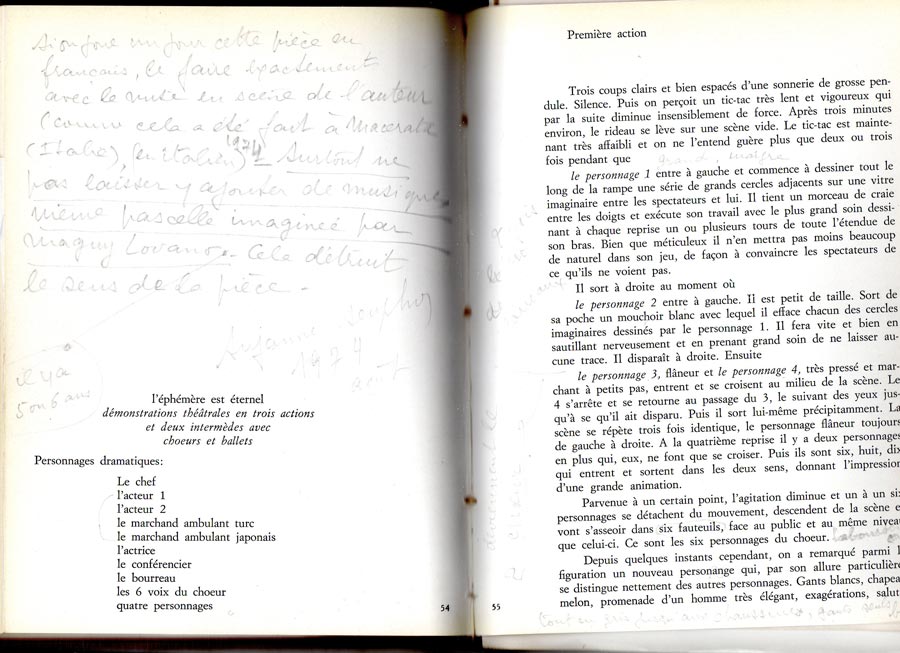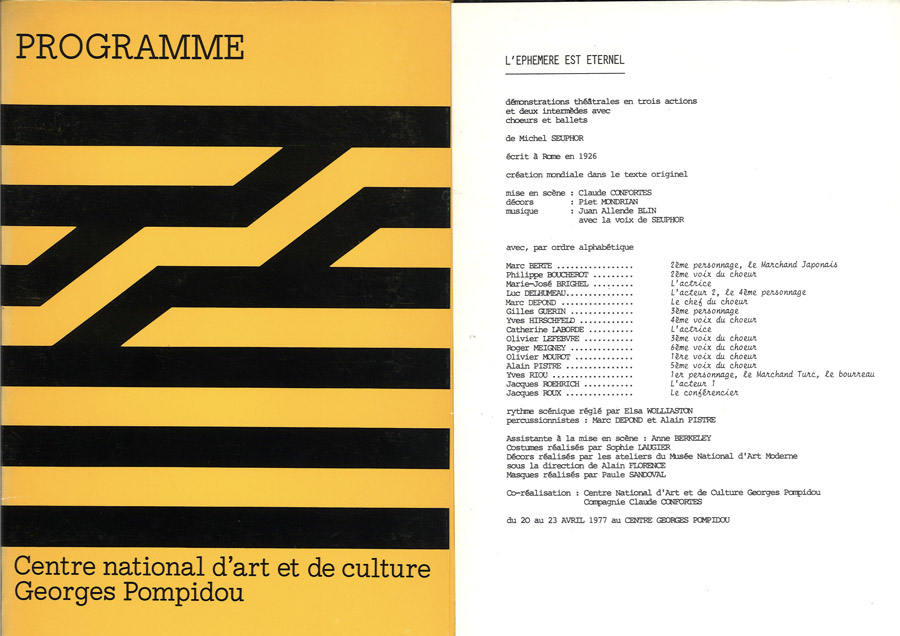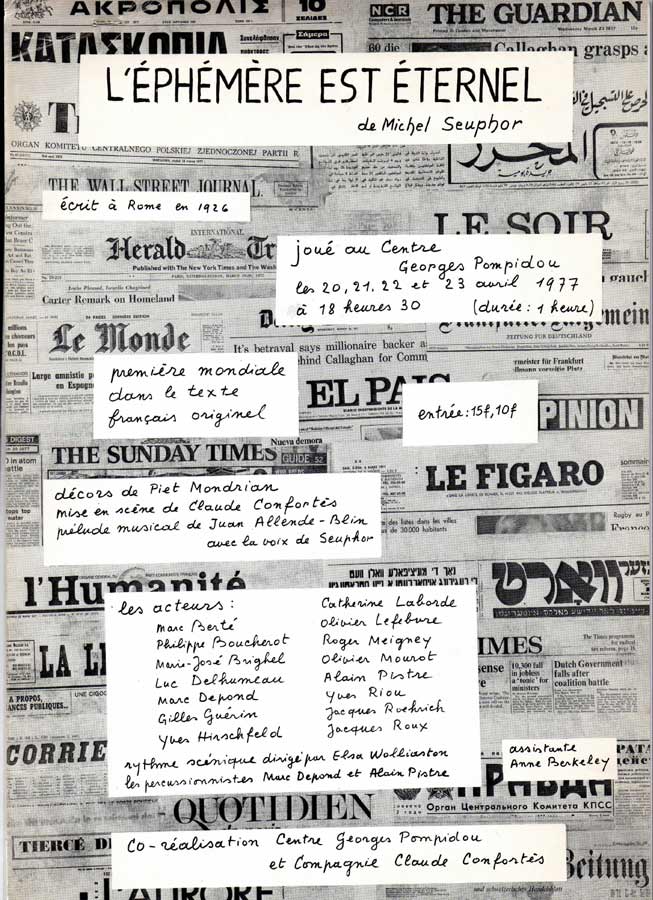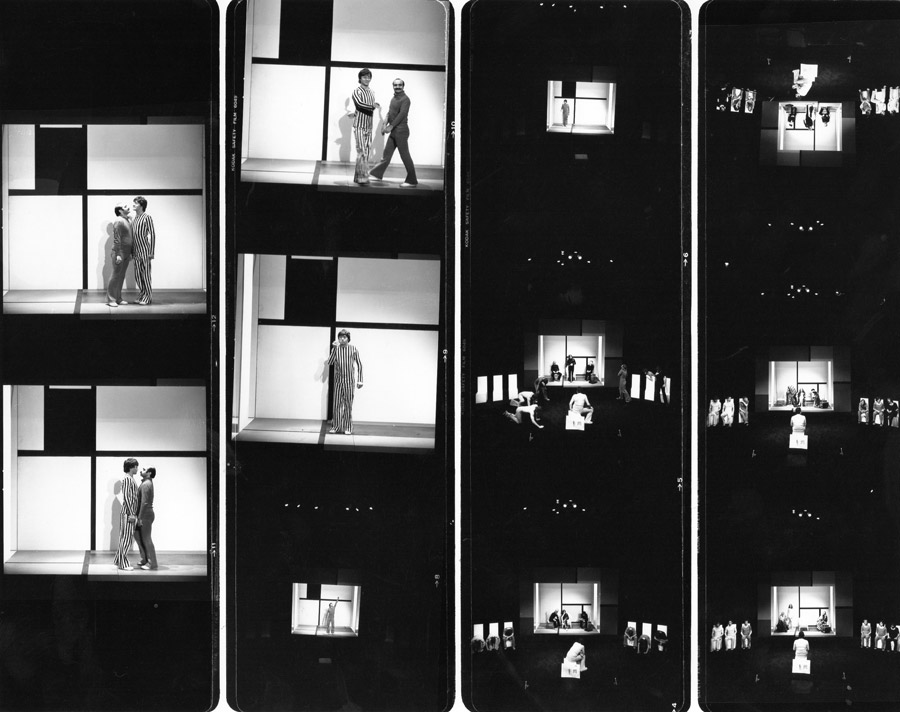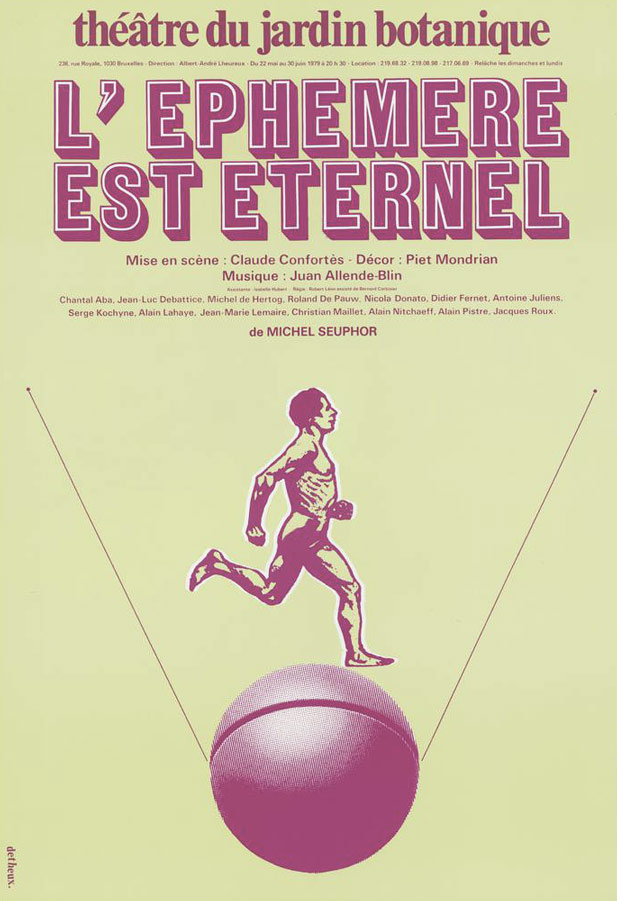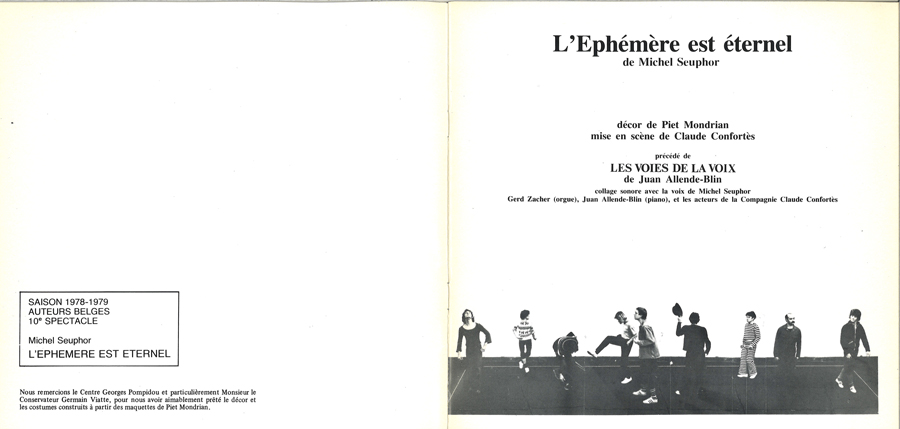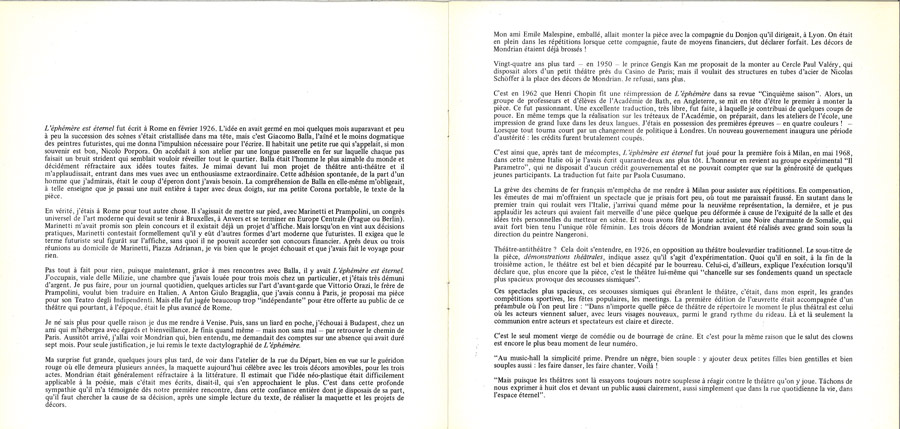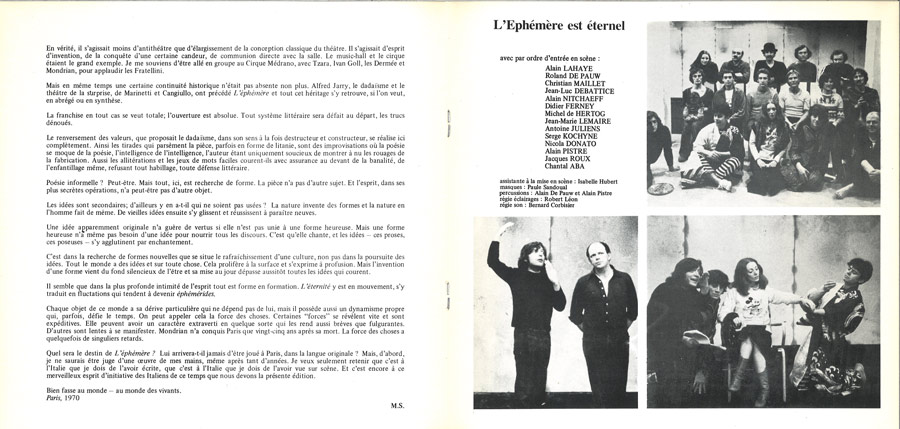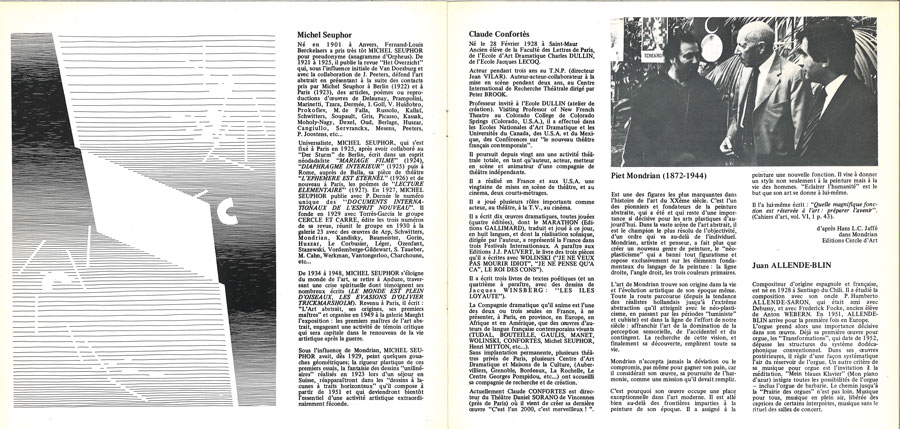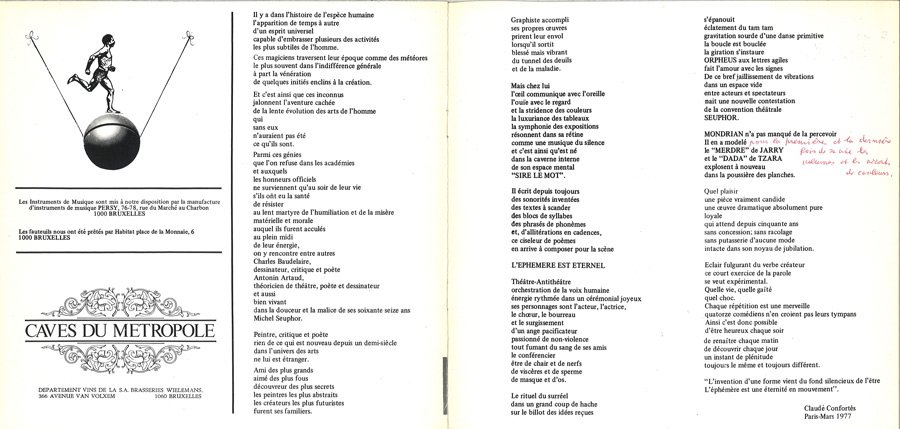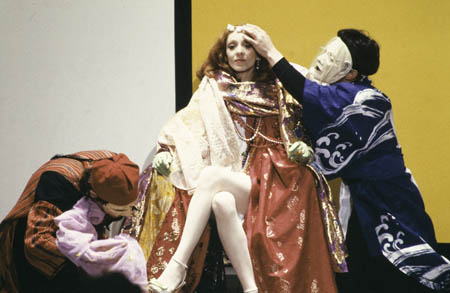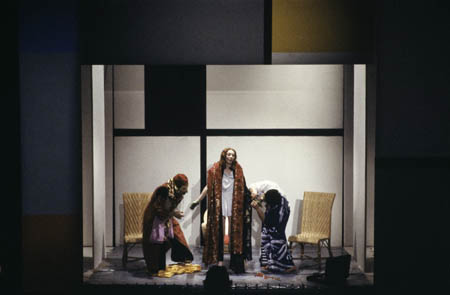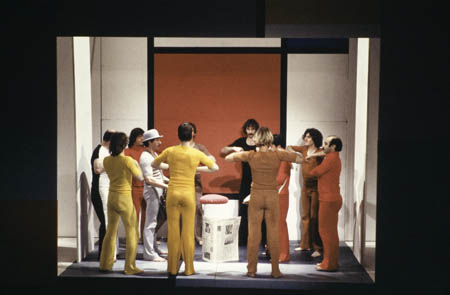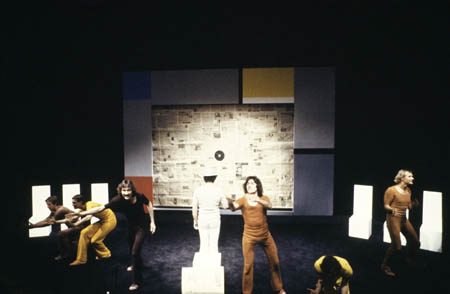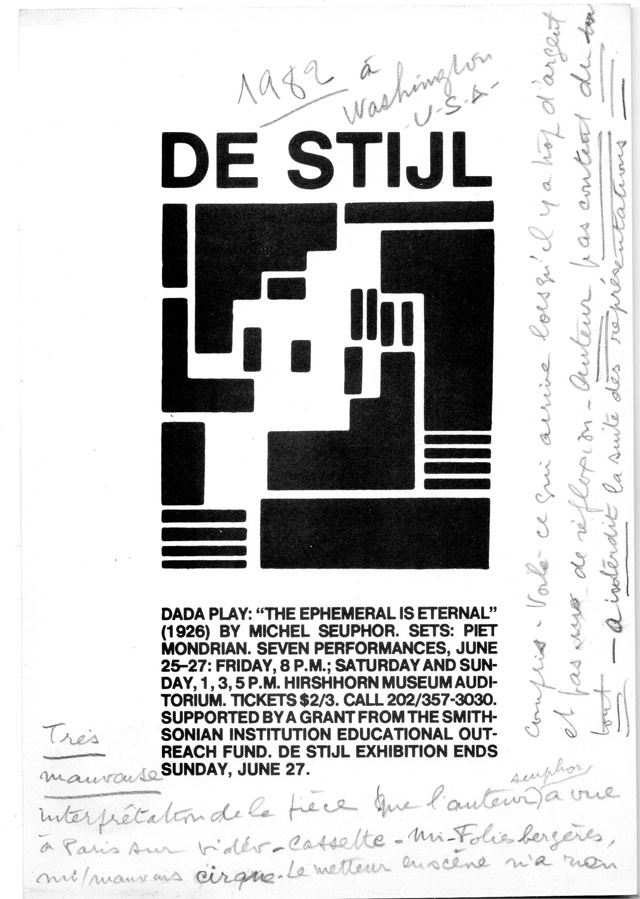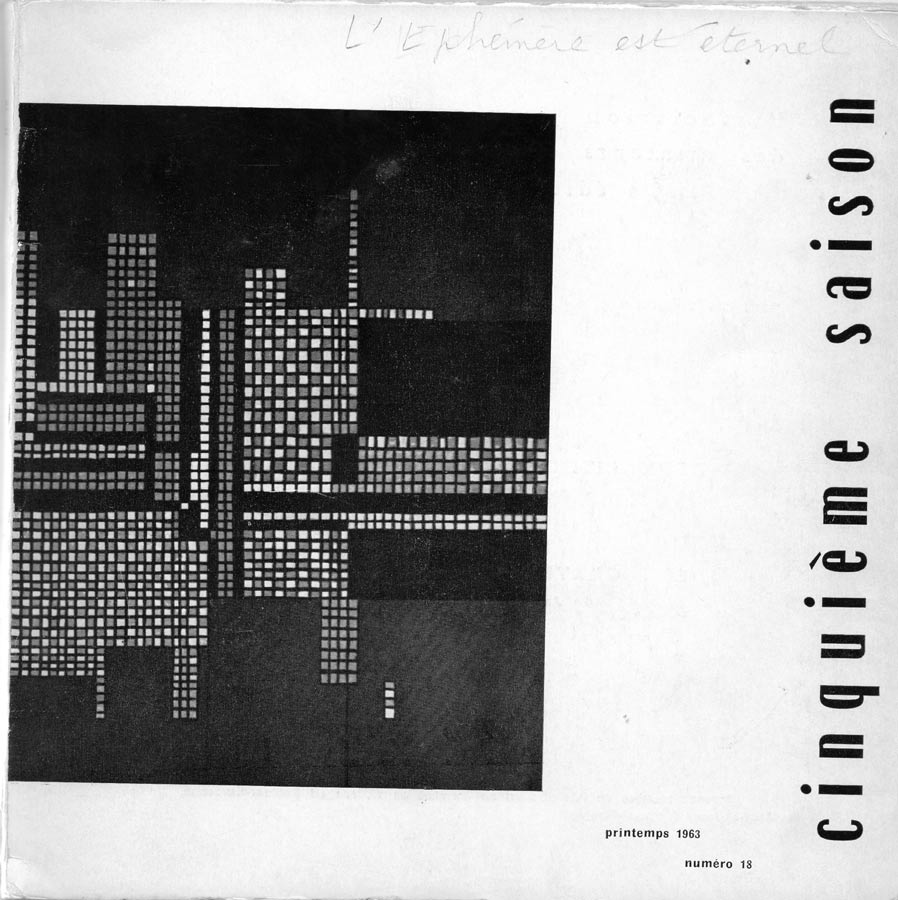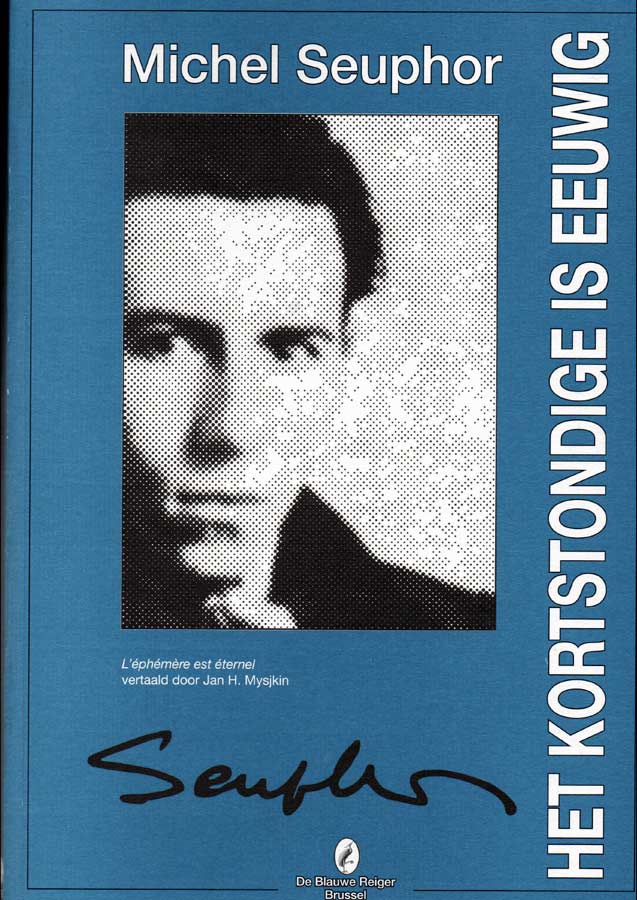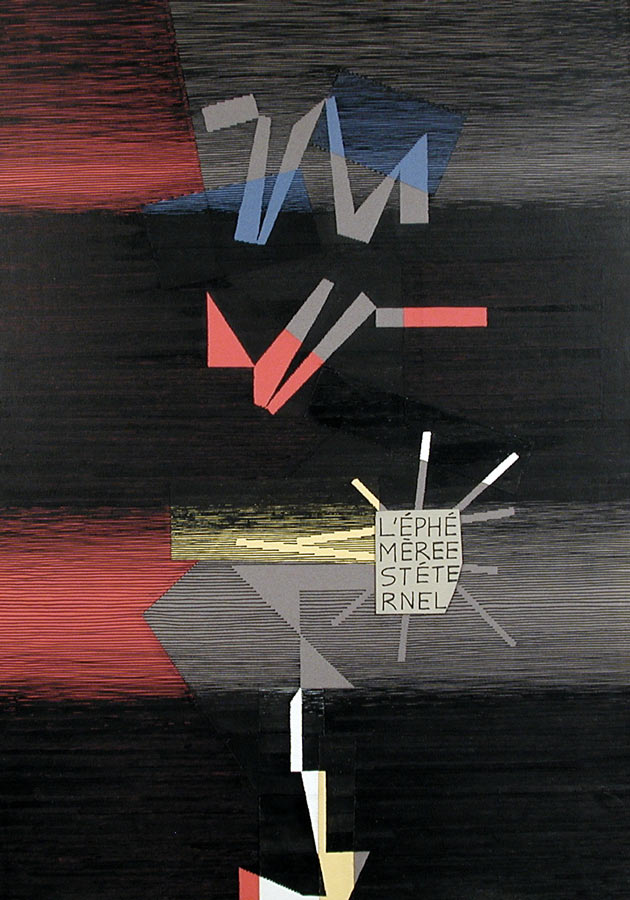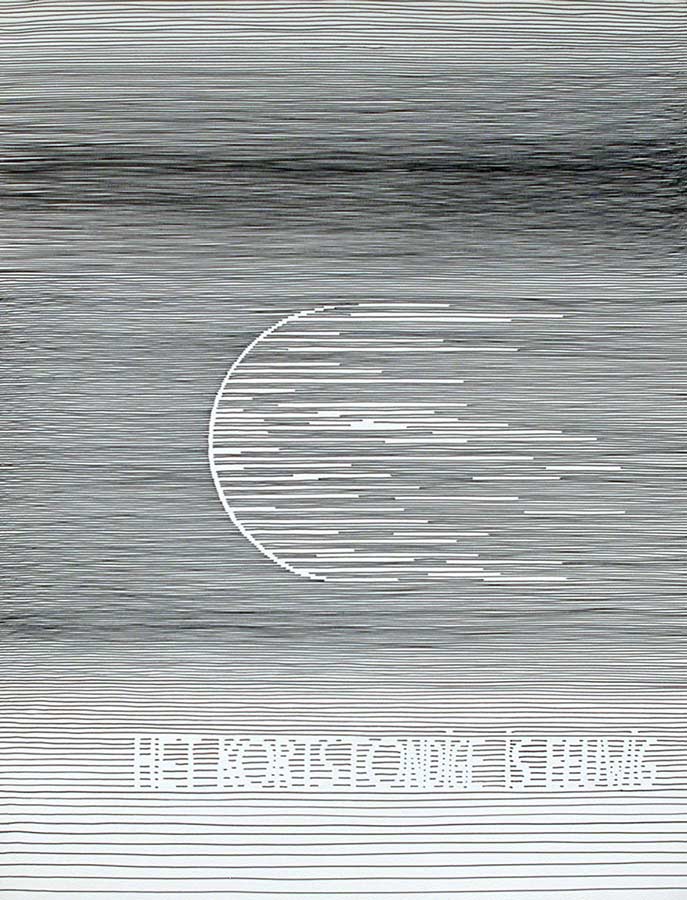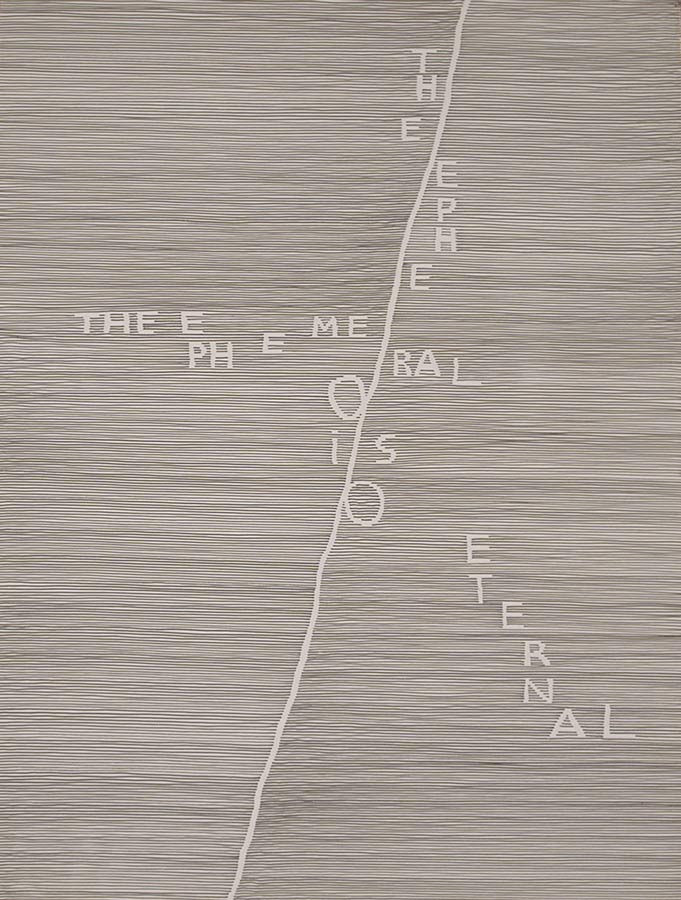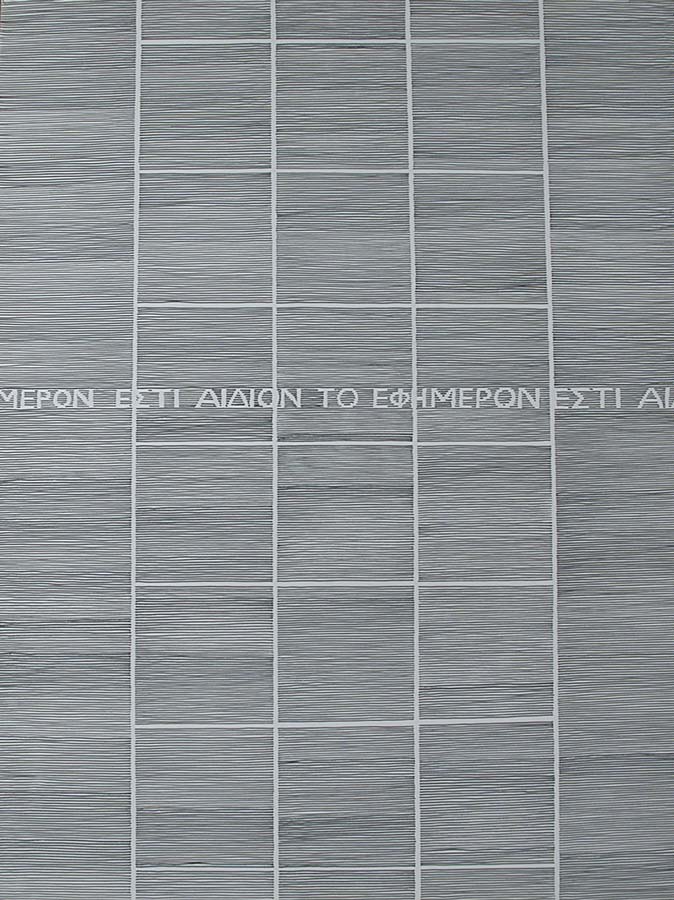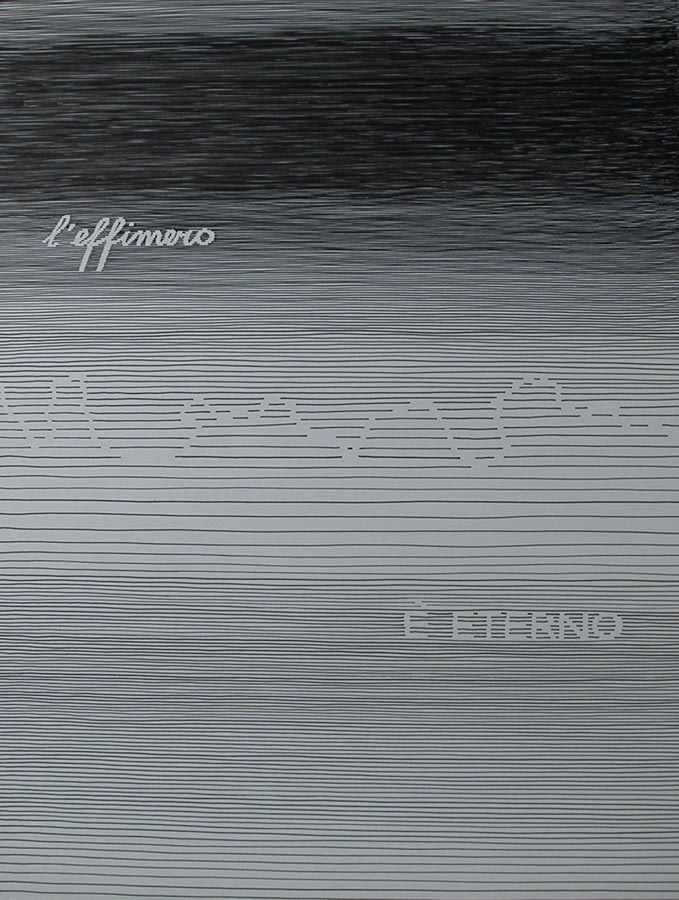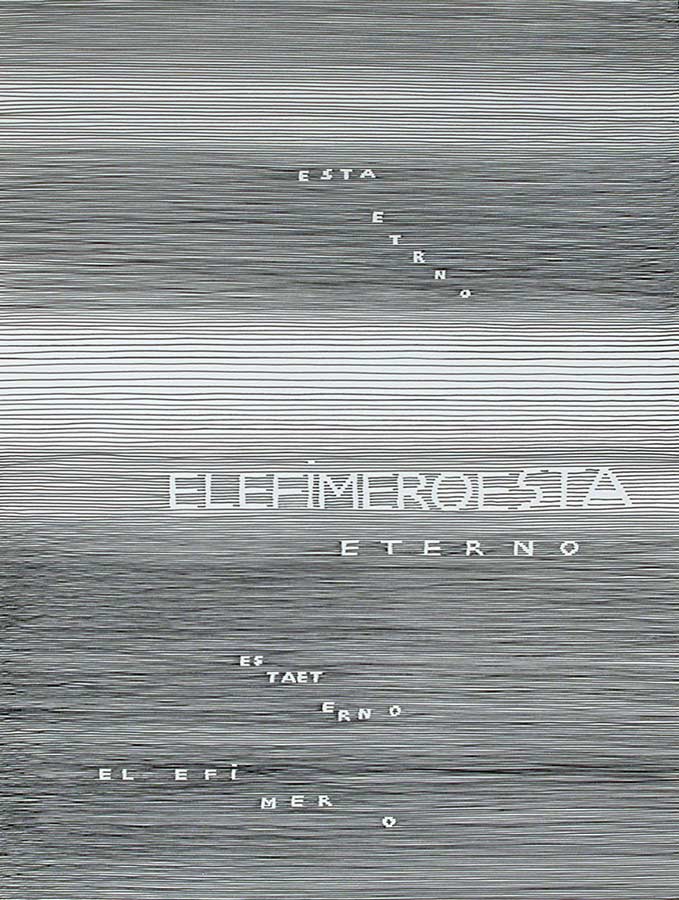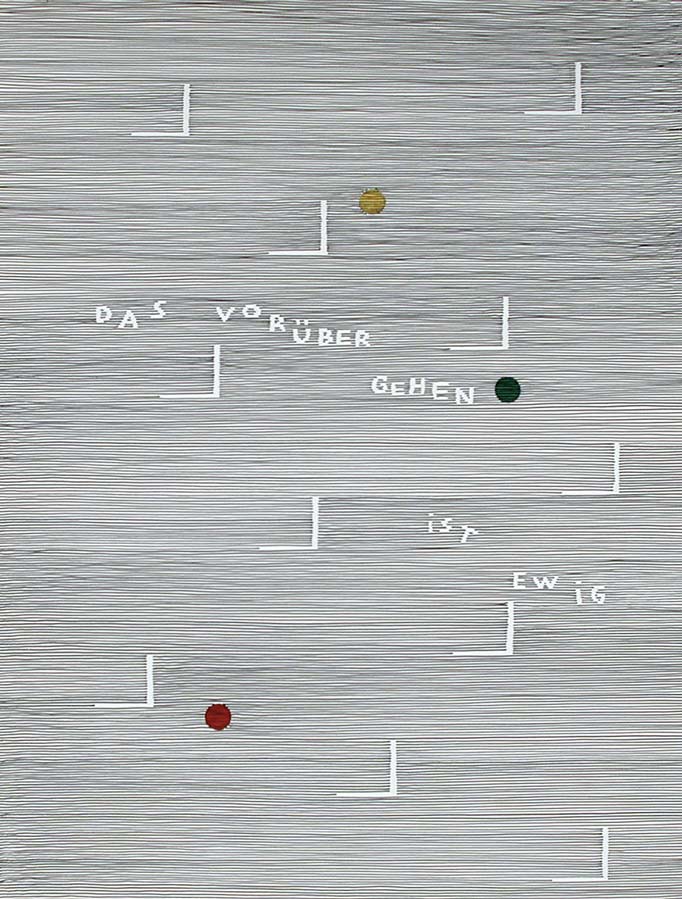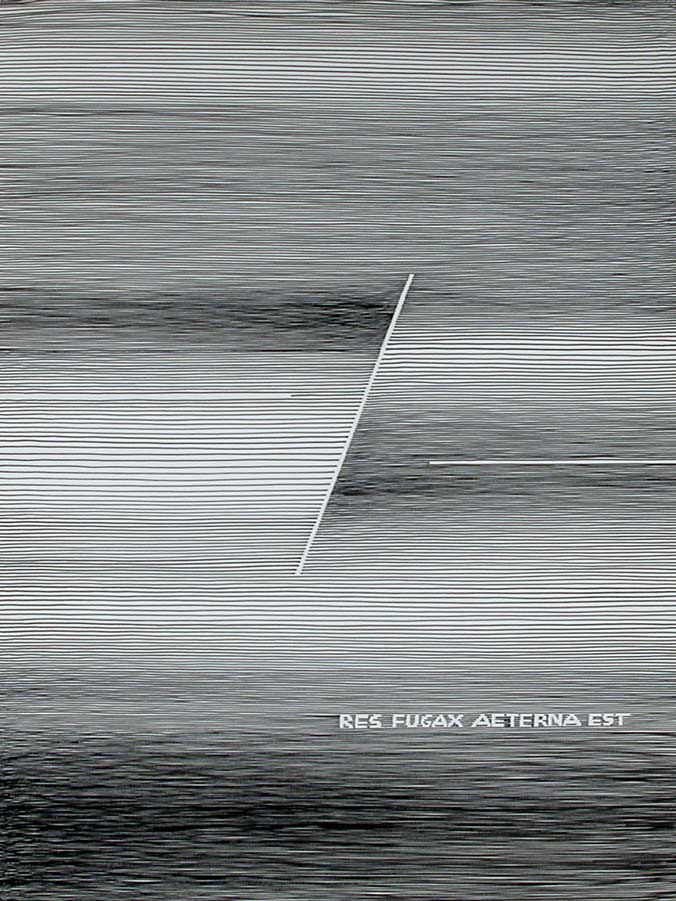THEATER
THEATER
« The Ephemeral is Eternal» was written in Rome in February 1926. The idea of it had germinated in me a few months before and little by little the succession of scenes had crystallized in my head, but it was Giacomo Balla, the eldest and least dogmatic of the Futurist painters, who gave me the necessary impulse to write it. He lived in a small street called, if I remember correctly, Nicolo Porpora. His studio was reached by a long iron footbridge on which each step made a shrill noise that seemed to wake up the whole neighborhood. Balla was the kindest man in the world and decidedly resistant to ready-made ideas. I mimed my project of an anti-theatrical theater in front of him and he applauded me, entering into my views with an extraordinary enthusiasm. This spontaneous acceptance, from a man I admired, was the spur I needed. The understanding of Balla in itself compelled me, so much so that I spent an entire night typing with two fingers, on my little portable Corona, the text of the play.» (…)
↑
The ephemeral is eternal
narrated by Michel Seuphor,
Text written in 1970 and appeared in the program booklet of the performances of the play at Beaubourg, Paris, 1977
« The Ephemeral is Eternal» was written in Rome in February 1926. The idea of it had germinated in me a few months before and little by little the succession of scenes had crystallized in my head, but it was Giacomo Balla, the eldest and least dogmatic of the Futurist painters, who gave me the necessary impulse to write it. He lived in a small street called, if I remember correctly, Nicolo Porpora. His studio was reached by a long iron footbridge on which each step made a shrill noise that seemed to wake up the whole neighborhood. Balla was the kindest man in the world and decidedly resistant to ready-made ideas. I mimed my project of an anti-theatrical theater in front of him and he applauded me, entering into my views with an extraordinary enthusiasm. This spontaneous acceptance, from a man I admired, was the spur I needed. The understanding of Balla in itself compelled me, so much so that I spent an entire night typing with two fingers, on my little portable Corona, the text of the play.» (…)
↑
The ephemeral is eternal
narrated by Michel Seuphor,
Text written in 1970 and appeared in the program booklet of the performances of the play at Beaubourg, Paris, 1977
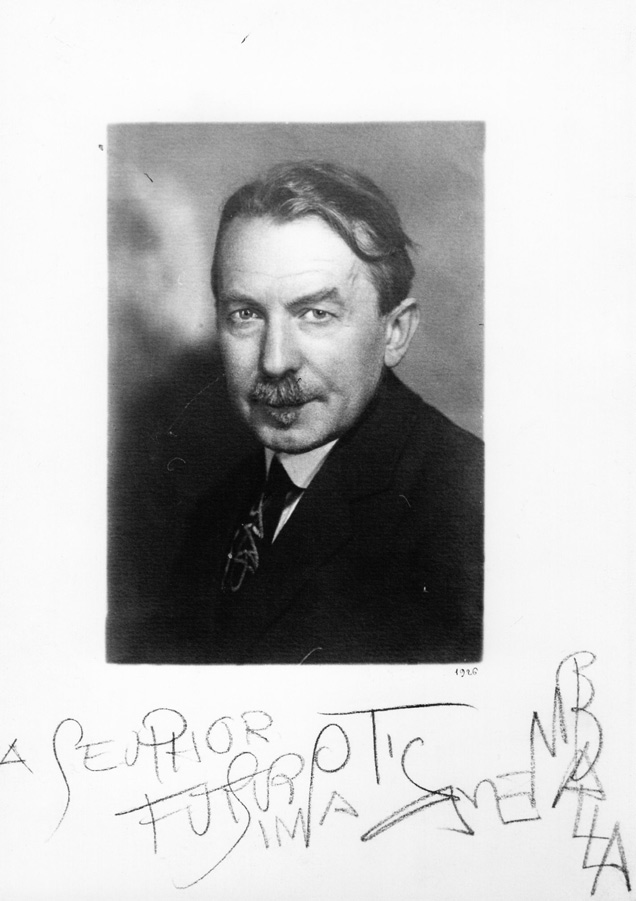
•
Photo of Balla given to Seuphor, 1926
1926
« As soon as I returned [to Paris], I went to see Mondrian, who, of course, asked me to account for my seven-month absence. As justification, I gave him the typed text of the Ephemeral.
A few days later, I was surprised to see the now-famous model for the three acts in [Mondiran’s] rue du départ studio, prominently displayed on the red pedestal table where it remained for several years.
Mondrian was generally resistant to literature. He thought that the neo-plastic idea was hardly applicable to poetry, but it was my writings, he said, that came closest. It is in this deep sympathy that he showed me from our first meeting, in this complete confidence that I had on his part, that we must look for the cause of his decision, after a simple reading of the text, to make the model and the project of the sets.» (…)
↑
The ephemeral is eternal
told by Seuphor
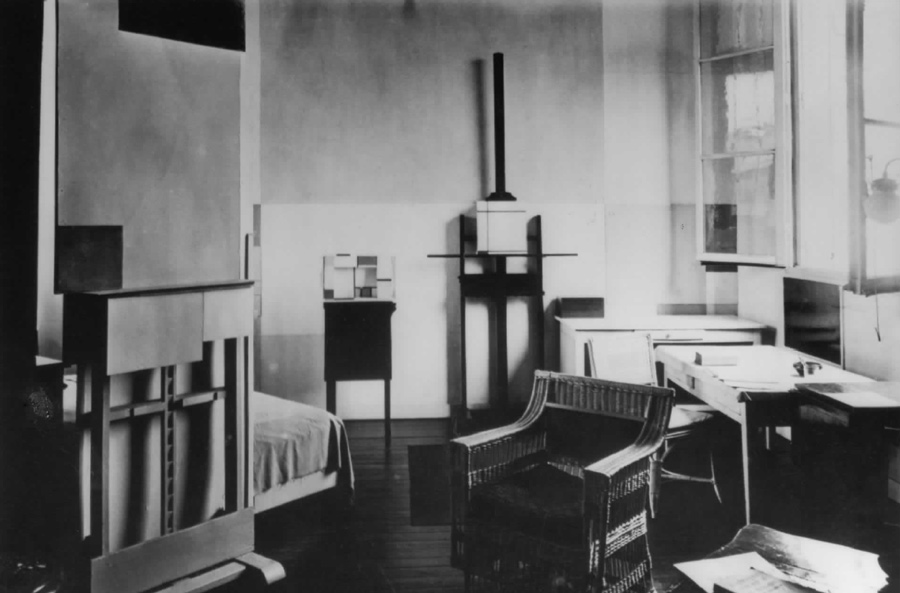
•
Photo taken by Seuphor in 1926 of Mondrian’s studio, with the model of the sets for the Ephemeral is Eternal.
« As soon as I returned [to Paris], I went to see Mondrian, who, of course, asked me to account for my seven-month absence. As justification, I gave him the typed text of the Ephemeral.
A few days later, I was surprised to see the now-famous model for the three acts in [Mondiran’s] rue du départ studio, prominently displayed on the red pedestal table where it remained for several years.
Mondrian was generally resistant to literature. He thought that the neo-plastic idea was hardly applicable to poetry, but it was my writings, he said, that came closest. It is in this deep sympathy that he showed me from our first meeting, in this complete confidence that I had on his part, that we must look for the cause of his decision, after a simple reading of the text, to make the model and the project of the sets.» (…)
↑
The ephemeral is eternal
told by Seuphor

•
Photo taken by Seuphor in 1926 of Mondrian’s studio, with the model of the sets for the Ephemeral is Eternal.
THE EPHEMERAL IS ETERNAL
Extract from the piece published in Lecture élémentaire
(Rougerie’s edition, volume III, which is exactly the same as the first edition of 1928).
« … Enter the scene, The Executioner. Heavy tread. A huge person dressed all in black, his chest covered with large medals. He talks with big heavy gestures, making his medals cling together.
The executioner : I am the executioner, for, as you know, there is an end to everything, a real end and an unreal end, which is the only real end, the only really beautiful end to everything. I have come to finish off this play. It may have seemed to you since the very beginning rather shaky, but you are wrong it isn’t the play, it’s the theatre that shakes on its foundations whenever a more spacious spectacle causes seismic shakes.
(…)
The executioner : So I’m going to finish off the play for you, (he mimes a beheading), but for that I need a shining metal blade. And this instrument, you are the ones (to the audience) who are to lend it to me.
The executioner folds his arms. At this moment, there is a huge burst of laughter in the gods, an imitation laugh, of ventriloquist’s, slow and with a regular rhythm:
O-ah, o-ah, o-ah…
O-ah, o-ah, o-ah…
O-ah, o-ah, o-ah…
The executioner: And that’s that! (he goes off) …
THE EPHEMERAL IS ETERNAL
Extract from the piece published in Lecture élémentaire
(Rougerie’s edition, volume III, which is exactly the same as the first edition of 1928).
« … Enter the scene, The Executioner. Heavy tread. A huge person dressed all in black, his chest covered with large medals. He talks with big heavy gestures, making his medals cling together.
The executioner : I am the executioner, for, as you know, there is an end to everything, a real end and an unreal end, which is the only real end, the only really beautiful end to everything. I have come to finish off this play. It may have seemed to you since the very beginning rather shaky, but you are wrong it isn’t the play, it’s the theatre that shakes on its foundations whenever a more spacious spectacle causes seismic shakes.
(…)
The executioner : So I’m going to finish off the play for you, (he mimes a beheading), but for that I need a shining metal blade. And this instrument, you are the ones (to the audience) who are to lend it to me.
The executioner folds his arms. At this moment, there is a huge burst of laughter in the gods, an imitation laugh, of ventriloquist’s, slow and with a regular rhythm:
O-ah, o-ah, o-ah…
O-ah, o-ah, o-ah…
O-ah, o-ah, o-ah…
The executioner: And that’s that! (he goes off) …
THE EPHEMERAL IS ETERNAL TOLD BY SEUPHOR (CONTINUATION)
Michel Seuphor. 1970. Tis text appeared in the program booklet of the performances of the play at the Centre Georges Pompidou, Paris, 1977.
« Theatre-anti-theatre? This must be understood, in 1926, in opposition to the traditional boulevardier theater. The subtitle of the play, « theatrical demonstrations» , indicates that it is about experimentation. In any case, at the end of the third action, the theater is indeed decapitated by the executioner. The executioner, moreover, explains the execution when he declares that, even more than the play, it is the theater itself that “shakes on its foundations whenever a more spacious spectacle causes seismic shakes.”
These more spacious spectacles, these seismic shakes that shake the theater, were, in my mind, the large sports competitions, the popular festivals, the meetings (…)
In truth, it was less a question of anti-theatre than of widening the classical conception of theater. It was about the spirit of creation, about conquering a certain candor, the direct communion with the audience. The music-hall and circus are excellent examples. I remember going to applaud the Fratellinis at the Médrano circus with Tzara, Yvan Goll, the Dermées and Mondrian.
But at the same time, a certain historical continuity remained. Alfred Jarry, Dadaism, and the surprise theater of Marinetti and Cangiullo preceded the Ephemeral. All this heritage can be found here, if you like, in abbreviation or synthesis.
In any case, frankness is total, openness is absolute. Any literary system would be undone upon the start, and the tricks would be unraveled.
The reversal of values, proposed by Dadaism, in its destructive and constructive sense, is completely accomplished here. Thus, the tirades which scatter the piece, sometimes in the form of litanies, are improvisations where poetry mocks poetry, and intelligence mocks intelligence. The author is only interested in undressing the nuts and bolts of the fabrication. Similarly, the alliterations and the easy puns run with assurance ahead of banality, pure childishness, refusing all dressing, all literary defense.
Informal poetry? Perhaps. But everything here is a search for form. The spectacle has no other subject. And the spirit in its most secret operations, has perhaps no other object.
Ideas are secondary. Besides, is there any that is not already worn out? Nature invents forms and nature in man does the same. Old ideas then slip in and manage to appear new.
An apparently original idea has little virtue if it is not united with a good form. But a good form does not even need an idea to feed any speech. It is because it sings, and the ideas -these proses, those poses – cling to it by enchantment.
The renewal of a culture lies in the search for new forms, not in the pursuit of ideas. Everyone has ideas about everything. They proliferates on the surface and are expressed in profusion. But the invention of a form comes from the silent bottom of the being and its update exceeds at once all the ideas which run.
It seems that, in the deepest intimacy of the spirit, everything is form in formation. Eternity is in movement there, it translates in fluctuations which tend to become ephemerides.»
↑
Sets by Mondrian in color, reproduced in the trilingual edition of Martano, in 1972.
THE EPHEMERAL IS ETERNAL TOLD BY SEUPHOR (CONTINUATION)
Michel Seuphor. 1970. Tis text appeared in the program booklet of the performances of the play at the Centre Georges Pompidou, Paris, 1977.
« Theatre-anti-theatre? This must be understood, in 1926, in opposition to the traditional boulevardier theater. The subtitle of the play, « theatrical demonstrations» , indicates that it is about experimentation. In any case, at the end of the third action, the theater is indeed decapitated by the executioner. The executioner, moreover, explains the execution when he declares that, even more than the play, it is the theater itself that “shakes on its foundations whenever a more spacious spectacle causes seismic shakes.”
These more spacious spectacles, these seismic shakes that shake the theater, were, in my mind, the large sports competitions, the popular festivals, the meetings (…)
In truth, it was less a question of anti-theatre than of widening the classical conception of theater. It was about the spirit of creation, about conquering a certain candor, the direct communion with the audience. The music-hall and circus are excellent examples. I remember going to applaud the Fratellinis at the Médrano circus with Tzara, Yvan Goll, the Dermées and Mondrian.
But at the same time, a certain historical continuity remained. Alfred Jarry, Dadaism, and the surprise theater of Marinetti and Cangiullo preceded the Ephemeral. All this heritage can be found here, if you like, in abbreviation or synthesis.
In any case, frankness is total, openness is absolute. Any literary system would be undone upon the start, and the tricks would be unraveled.
The reversal of values, proposed by Dadaism, in its destructive and constructive sense, is completely accomplished here. Thus, the tirades which scatter the piece, sometimes in the form of litanies, are improvisations where poetry mocks poetry, and intelligence mocks intelligence. The author is only interested in undressing the nuts and bolts of the fabrication. Similarly, the alliterations and the easy puns run with assurance ahead of banality, pure childishness, refusing all dressing, all literary defense.
Informal poetry? Perhaps. But everything here is a search for form. The spectacle has no other subject. And the spirit in its most secret operations, has perhaps no other object.
Ideas are secondary. Besides, is there any that is not already worn out? Nature invents forms and nature in man does the same. Old ideas then slip in and manage to appear new.
An apparently original idea has little virtue if it is not united with a good form. But a good form does not even need an idea to feed any speech. It is because it sings, and the ideas -these proses, those poses – cling to it by enchantment.
The renewal of a culture lies in the search for new forms, not in the pursuit of ideas. Everyone has ideas about everything. They proliferates on the surface and are expressed in profusion. But the invention of a form comes from the silent bottom of the being and its update exceeds at once all the ideas which run.
It seems that, in the deepest intimacy of the spirit, everything is form in formation. Eternity is in movement there, it translates in fluctuations which tend to become ephemerides.»
↑
Sets by Mondrian in color, reproduced in the trilingual edition of Martano, in 1972.
THE REPRESENTATIONS OF THE EPHEMERAL IS ETERNAL
After several failed attempts, the play was staged for the first time in Milan in 1968 by the experimental theater group Il Paramentro, in sets reconstructed after Mondrian’s model. The play was performed in an Italian translation: l’effimero è eterno. Because of the 1968 strikes in France, Seuphor could not participate in the staging, which he did not particularly appreciate. He managed to attend only the ninth and last performance.
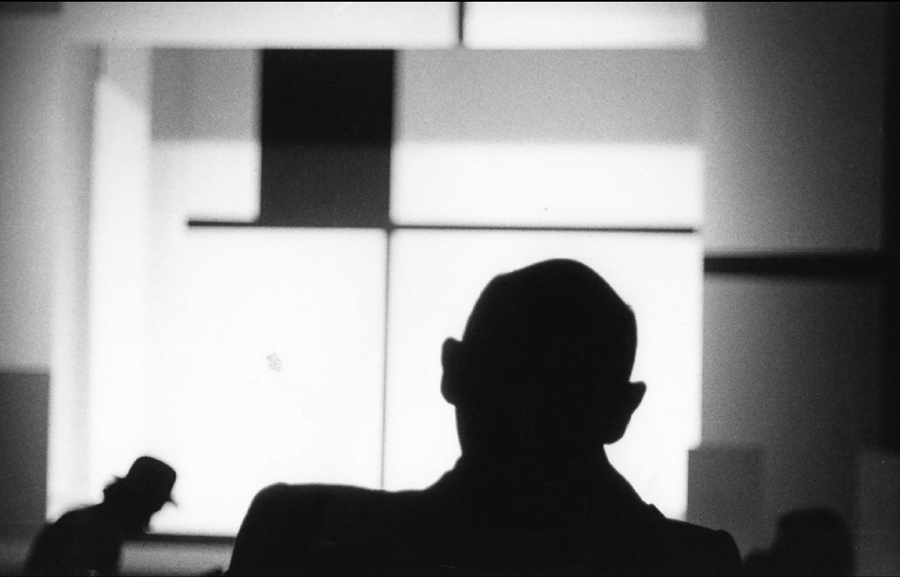
•
Photo of Michel Seuphor attending the rehearsals of the play at the Centre Georges Pompidou.
THE REPRESENTATIONS OF THE EPHEMERAL IS ETERNAL
After several failed attempts, the play was staged for the first time in Milan in 1968 by the experimental theater group Il Paramentro, in sets reconstructed after Mondrian’s model. The play was performed in an Italian translation: l’effimero è eterno. Because of the 1968 strikes in France, Seuphor could not participate in the staging, which he did not particularly appreciate. He managed to attend only the ninth and last performance.

•
Photo of Michel Seuphor attending the rehearsals of the play at the Centre Georges Pompidou.
In 1977, the play was finally staged for the first time in France in its original version at the Centre Georges-Pompidou in Paris, in the reconstructed sets of Mondrian. The four performances, which took place as part of a major retrospective of all of Seuphor’s work, were directed by Claude Confortès, this time with a great deal of involvement from the author, who was delighted with the result.
•
Poster and program of the performances at the Centre Georges Pompidou.In 1977, the play was finally staged for the first time in France in its original version at the Centre Georges-Pompidou in Paris, in the reconstructed sets of Mondrian. The four performances, which took place as part of a major retrospective of all of Seuphor’s work, were directed by Claude Confortès, this time with a great deal of involvement from the author, who was delighted with the result.
•
Photos of one of the performances of the play.
Two years later, in 1979, thirty performances of the play were given at the Théâtre du Jardin Botanique in Brussels. Claude Confortès was again the director, with a co-production of the Théâtre de l’Esprit Frappeur.
•
Photos of one of the performances of the play.
Two years later, in 1979, thirty performances of the play were given at the Théâtre du Jardin Botanique in Brussels. Claude Confortès was again the director, with a co-production of the Théâtre de l’Esprit Frappeur.
•
Photos of the performances at the Botanical Garden Theater in May-June 1979 ©AML (Archives and Museum of Literature) NHDT 00015-00017, Katina Avgouloupis.
•
Photos of the performances at the Botanical Garden Theater in May-June 1979 ©AML (Archives and Museum of Literature) NHDT 00015-00017, Katina Avgouloupis.
The piece was also staged once in Washington in 1982 for a De Stijl exhibition, but Seuphor, who watched the performance on video in Paris, was very unhappy with it. « It was half barnstorming, half bad circus. The director did not understand anything. This is what happens when there is too much money and not enough thought. The author, not happy at all, forbade further performances» wrote Suzanne Seuphor on a poster of the play.
The piece was also staged once in Washington in 1982 for a De Stijl exhibition, but Seuphor, who watched the performance on video in Paris, was very unhappy with it. « It was half barnstorming, half bad circus. The director did not understand anything. This is what happens when there is too much money and not enough thought. The author, not happy at all, forbade further performances» wrote Suzanne Seuphor on a poster of the play.
EDITIONS AND TRANSLATIONS
EDITIONS IN FRENCH
First published in Lecture élémentaire, published by Les Écrivains Réunis, 1928.
Mondrian’s sets were published in black and white in the single issue of « Documents internationaux de l’esprit nouveau », 1929.
Second publication in the magazine Cinquième saison, n°18, spring 1963.
Reissue of Lecture élémentaire by Rougerie Editions in 1989, volume III, in eleven copies. The text is an exact copy of the first edition of 1928.
TRANSLATIONS
Trilingual edition by Martano in Turin in 1972. The three languages are: the original language, French; Italian, thanks to Paola Cusumano’s translation for the Milan performances; and English. This third English translation was realized by the wife of Henri Chopin, director of the magazine Cinquième Saison, under the direction of Seuphor, following the publication of the play in this magazine in 1963. Its purpose was to organize a performance by a group of teachers and students of the Bath Academy, which did not take place in the end.
Edition of the Dutch translation by De Blauwe Reiger, entrusted by the editor Agnès Caers to the poet-translator Jan H. Misjkin in 2014.
EDITIONS AND TRANSLATIONS
EDITIONS IN FRENCH
First published in Lecture élémentaire, published by Les Écrivains Réunis, 1928.
Mondrian’s sets were published in black and white in the single issue of « Documents internationaux de l’esprit nouveau », 1929.
Second publication in the magazine Cinquième saison, n°18, spring 1963.
Reissue of Lecture élémentaire by Rougerie Editions in 1989, volume III, in eleven copies. The text is an exact copy of the first edition of 1928.
TRANSLATIONS
Trilingual edition by Martano in Turin in 1972. The three languages are: the original language, French; Italian, thanks to Paola Cusumano’s translation for the Milan performances; and English. This third English translation was realized by the wife of Henri Chopin, director of the magazine Cinquième Saison, under the direction of Seuphor, following the publication of the play in this magazine in 1963. Its purpose was to organize a performance by a group of teachers and students of the Bath Academy, which did not take place in the end.
Edition of the Dutch translation by De Blauwe Reiger, entrusted by the editor Agnès Caers to the poet-translator Jan H. Misjkin in 2014.
LACUNA DRAWINGS OF THE EPHEMERAL IS ETERNAL
In the excitement of preparing for the performance of the play at the Georges Pompidou Center, Seuphor created the first lacuna drawing of L’Éphémère est éternel. It is a « sign drawing” (tableau ensigne) where the title in French appears nestled in the middle of a rich and colorful composition
Then, at the time of the performances at the Théâtre du Jardin Botanique in Brussels in May 1979, Seuphor produced a series of eight black and white lacuna drawings in which the title of the play appeared in eight different languages; in the order of creation: Ancient Greek, Latin, Dutch, Italian, German, English, Hebrew and Spanish. He then gave the painting in Hebrew to his friend the painter Janco and it was never seen again.
LACUNA DRAWINGS OF THE EPHEMERAL IS ETERNAL
In the excitement of preparing for the performance of the play at the Georges Pompidou Center, Seuphor created the first lacuna drawing of L’Éphémère est éternel. It is a « sign drawing” (tableau ensigne) where the title in French appears nestled in the middle of a rich and colorful composition
Then, at the time of the performances at the Théâtre du Jardin Botanique in Brussels in May 1979, Seuphor produced a series of eight black and white lacuna drawings in which the title of the play appeared in eight different languages; in the order of creation: Ancient Greek, Latin, Dutch, Italian, German, English, Hebrew and Spanish. He then gave the painting in Hebrew to his friend the painter Janco and it was never seen again.

